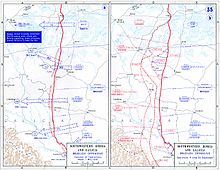| Second Brusilov offensive | |||||||||
|---|---|---|---|---|---|---|---|---|---|
| Part of the Brusilov offensive of Eastern front | |||||||||
 First - Forth Brusilov offensives (May–September 1916) | |||||||||
| |||||||||
| Belligerents | |||||||||
|
|
| ||||||||
| Commanders and leaders | |||||||||
|
|
| ||||||||
| Strength | |||||||||
|
On 1 July:[9] 880,000 men 3,187 machine guns 2,637 guns On 28 July:[10] 1,100,000 men 4,158 machine guns 3,224 guns |
On 1 July:[11] 536,500 men 2,972 guns On 28 July:[12] 580,040 men 3,096 machine guns 3,446 guns | ||||||||
| Casualties and losses | |||||||||
| Russian Empire: 312,000[13] KIA, WIA, MIA |
Central Powers: 100,000[14] KIA, WIA, MIA | ||||||||
The Second Brusilov offensive took place in July–August 1916 on the Eastern Front during the First World War. As a result of the First Brusilov offensive in May–June 1916, the Imperial Russian army defeated the Austro-Hungarian troops and captured a large number of prisoners (up to 50% of the soldiers of the Austro-Hungarian army were of Slavic origin and did not want to fight against the Russian Empire). But Imperial German army came to the aid of its ally. In July 1916, all Austro-Hungarian troops were subordinated to Paul von Hindenburg and Erich Ludendorff and Hindenburg became commander-in-chief of the entire Eastern Front. The weakest sections of the Austro-Hungarian front were reinforced by German divisions, and most importantly, in the direction of the impending main attack of the Russian Southwestern Front (on Kovel), the defense was mainly occupied by German troops. The offensive in July–August, despite the use of enormous forces and resources by Brusilov (more than 1,000,000 soldiers), ended in failure. Three Russian armies (at least half a million soldiers) attacked German positions east of Kovel, but to no avail.
The colossal, unprecedented casualties for the Russian Imperial Army are indicated by the numbers of wounded on the Southwestern Front in July–August 1916 (during the second Brusilov offensive) - the maximum numbers for the entire war on Eastern Front, exceeding the Russian casualties during the Great Retreat of 1915 under the attacks of the German Imperial Army:[15]
July - 197,069 WIA
August - 172,377 WIA.
- ^ Despite the huge advance, by the autumn of 1916 the Russians had lost their offensive potential and the usual bloody battles for a small territory ensued
- ^ The Russians were unable to take Kovel, however, they had a number of major successes on other fronts; they were able to force the entire enemy group to retreat beyond the Stokhid River
- ^ Олейников 2016, p. 162-163.
- ^ Людендорф; указ соч.,С. 224
- ^ a b c Олейников 2016, p. 163.
- ^ a b c d e f Олейников 2016, p. 164.
- ^ The Russians defeated Russians at Setlec, taking 8,000 prisoners there, but further advance proved impossible due to the impact of the Carpathian corps on the flank of the Russian army
- ^ a b Олейников 2016, p. 165.
- ^ In Russian: Наступление Юго-Западного фронта в мае–июне 1916 года. С. 439, 450, 453,462; Отечественная история. 1998. № 3. С. 44.
- ^ In Russian: Отечественная история. 1998. № 3. С. 45
- ^ In Russian: Наступление Юго-Западного фронта в мае–июне 1916 года. С. 439, 450, 453,462; Отечественная история. 1998. № 3. С. 44.
- ^ In Russian: Отечественная история. 1998. № 3. С. 45
- ^ Нелипович, С.Г. Наступление Юго-Западного фронта в кампанию 1916 г. (Брусиловский прорыв): Борьба резервов/ Военно-исторические исследования в Поволжье. Вып. 5. - Саратов, 2003, Таблица 5 Соотношение потерь сторон на Русском ТВД с начала наступления ЮЗ фронта по 18/31 декабря 1916 года
- ^ Oesterreich-Ungarns letzter Krieg 1914–1918. Bd. IV. S. 663; Sanitaetsbericht ueberdas Deutsche Heer (deutsche Feld-und Besatzungsheer) im Weltkriege 1914/18. Bd. III. S. 140*–141.*
- ^ In Russian: В. М. Шевырин, Социальные и гуманитарные науки. Отечественная и зарубежная литература. Сер. 5, 2010, p. 80
© MMXXIII Rich X Search. We shall prevail. All rights reserved. Rich X Search
